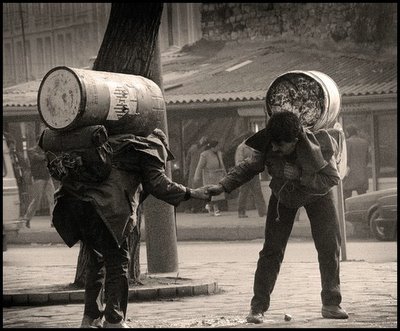 This image shows a porter helping his colleague as they carry their heavy burdens up from the harbour into Istanbul.
This image shows a porter helping his colleague as they carry their heavy burdens up from the harbour into Istanbul.It always symbolised something of the human condition to me and for a many years it resided in my photojournalism portfolio.
I'm fond of it. This was a real grab shot taken literally on the run as I saw the action unfolding in front of me. It was an icy day with low light and I was shooting with Ilford HP5 up rated to squeeze an extra stop out of it. Taken with my 70-210mm zoom at full extension.
But should it be in my portfolio? The feet of the one guy are are cut-off. Sometimes I like this because it looks as if he is anchored to the side of the frame making the task of moving even harder. Other times I wish I had it all in.
What do you think? Should it be in my portfolio or finally out? These are the questions I posed on a photographic site. The response was unanimous. The image is just too special to leave out. So it shows that sometimes the subject matter and other elements are strong enough to overcome the technical dogma.
Paul Indigo
Comments
D
Have a nice day!